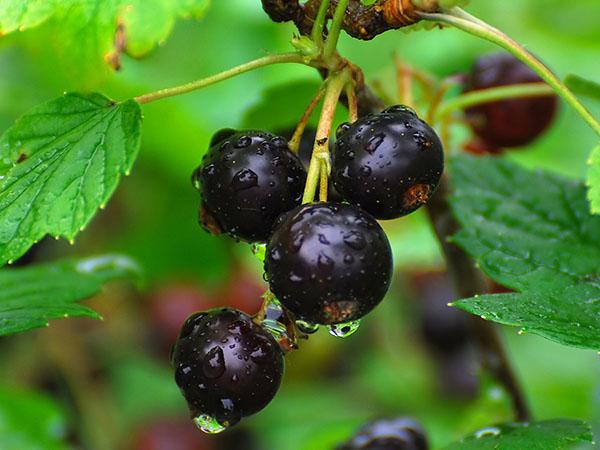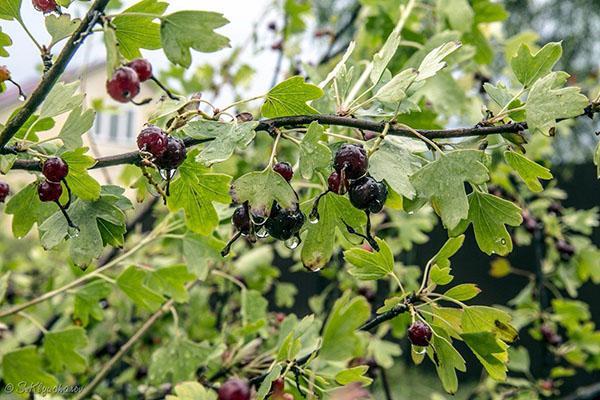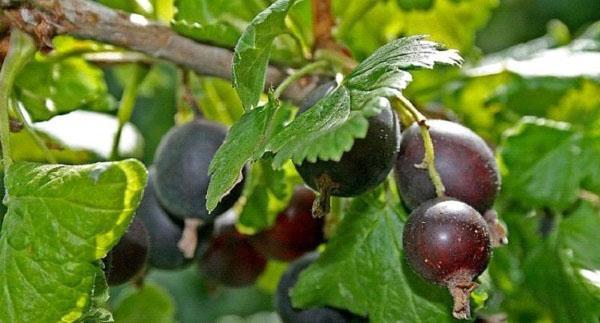How to grow yoshta in a garden: reproduction, planting and care features
 Yoshta is a hybrid of gooseberries and black currants, bred by a German amateur breeder in the 80s of the last century. If yoshta grows in the garden, planting and caring, reproduction and cultivation are not difficult for the owner of this amazing plant.
Yoshta is a hybrid of gooseberries and black currants, bred by a German amateur breeder in the 80s of the last century. If yoshta grows in the garden, planting and caring, reproduction and cultivation are not difficult for the owner of this amazing plant.
This is a perennial graceful shrub up to one and a half meters high and a crown diameter of up to two meters. It got its name from two words of the German language: Johannisbeere and Stachelbeere, which means currants and gooseberries.
Description

The berries are large, dark purple, almost black in color, sourish in taste, have the aroma of both currants and gooseberry... You can get up to 5 kg of berries from one bush. The berries ripen unevenly, so the crop can be harvested from July until frost.
At the beginning of ripening, the berries are hard and crunchy, when fully ripe they become juicy with a sweet and sour taste and aroma of nutmeg. Covered with a very dense skin. The berries do not crumble, they are firmly attached to the stalks.
The bush consists of 15-20 large, strong shoots of different ages. The depth of the roots is up to 40 cm. In the spring the plant is covered with beautiful bright flowers. Blooms in May, sometimes again in September.
 Unlike gooseberry, it has no thorns, there is no strong aroma characteristic of currants. Growing and caring for yoshta is not difficult due to the unpretentiousness of the plant. Resistant to cold temperatures and pests. The beginning of fruiting is in the second year after planting. The maximum yield is achieved in 3-4 years.
Unlike gooseberry, it has no thorns, there is no strong aroma characteristic of currants. Growing and caring for yoshta is not difficult due to the unpretentiousness of the plant. Resistant to cold temperatures and pests. The beginning of fruiting is in the second year after planting. The maximum yield is achieved in 3-4 years.
The most popular varieties of yoshta are: Triton, Odzhebin, Rudkis, Titania, Black Silvergiters, from Russian varieties - a hybrid of Zvyagintseva.
Has healing properties. They are used for diseases of the gastrointestinal tract, to improve blood circulation, to remove radioactive substances and heavy metals. Berries are rich in vitamins C, P, anthocyanins. Vitamin C is slightly lower than in currants.
It is resistant to diseases and pests, tolerates the absence of sunlight well, although it grows and bears fruit better in well-lit sunny areas.
Reproduction of yoshta
 After planting, reproduction and care of the yoshta require regularity and thoroughness, although much effort is not required to do this. Yoshta can be propagated by all methods known in gardening:
After planting, reproduction and care of the yoshta require regularity and thoroughness, although much effort is not required to do this. Yoshta can be propagated by all methods known in gardening:
- Autumn cuttings. The most popular way. Young barked shoots of this year should be pruned in the fall. Cut these shoots into smaller cuttings 15-20 cm long. Leave 4-5 buds on each such shoot. Plant in the ground, leaving 2 buds on the surface.
- Summer cuttings. Cut the green branches into cuttings up to 15 cm long. Remove all leaves except the top two. On the shoots, make a longitudinal incision above each bud. Plant under a film at a slight angle, periodically loosen and water.
Yoshta care, planting during propagation by cuttings does not require much effort, this method is common even among inexperienced gardeners.Therefore, cuttings can be considered the most preferred method of propagation of this plant. - By dividing the bushes. Produced in spring or autumn. It is necessary to cut off the overgrown roots, divide the bush into several parts, process the cuts with garden pitch and plant each part of the bush in a new place.
- Seeds. This method is rarely used, usually when you need to get a new yoshta variety. The seeds are mixed with wet, pre-steamed sand, then placed in a cool place. It is necessary to periodically moisten the sand.
- Layers. Dig up the soil around the bush, water abundantly, make grooves in the ground from the center of the bush in different directions, then bent the outer young shoots to the ground, fix with brackets and sprinkle with earth. Transplant independent rooted bushes in a year.
If the seeds germinate before spring, then they should be planted in pots on the windowsill or in a snow pile until spring. In the spring, the seedlings are hardened and planted in the ground.
Yoshta: planting and care
 Yoshta is grown in separate bushes or in boles. Among gardeners, there is an opinion that yoshta develops well and bears fruit only in the vicinity of gooseberries and black curranttherefore it is often grafted onto gooseberries or golden currant or used as a stock stock of currants and gooseberries.
Yoshta is grown in separate bushes or in boles. Among gardeners, there is an opinion that yoshta develops well and bears fruit only in the vicinity of gooseberries and black curranttherefore it is often grafted onto gooseberries or golden currant or used as a stock stock of currants and gooseberries.
It is best to transplant yoshta in the fall: in late September or early October. The bush should take root before the fall frosts, accumulate nutrients and build up the root system.
Planting yoshta in spring is less preferable for gardeners. In spring, the air temperature rises rapidly, this leads to drying out of the soil. And yoshta loves moisture. When planted in spring, cuttings root well by autumn and give the first harvest the next year.
In one place the plant bears fruit for up to 18 years. Then you will need to transplant to another place.
How to plant
 Growing yoshta requires a sunny, spacious place: over time, the bush grows strongly. You need to plant in a row at a distance of 1.5 meters; it is recommended to leave 2 meters between rows.
Growing yoshta requires a sunny, spacious place: over time, the bush grows strongly. You need to plant in a row at a distance of 1.5 meters; it is recommended to leave 2 meters between rows.
Often used for hedges. To do this, young shoots must be planted at a close distance from each other. It is not recommended to place the plant in the center of the plot, so as not to shade other plantings.
Joshta is not afraid of winds and drafts. Grows poorly on sandy soils and peat bogs. Prefers loamy places.
You need to know how to plant yoshta in the spring, because this will require special attention to the choice of seedlings. Planting material must be of good quality, with a strong root system.
Any dry or rotten areas should be removed. Place in water or a weak solution of potassium permanganate before planting. The seedlings should be young, with a smooth elastic bark and a strong root system.
Soil preparation
A hole of 50-60 cm should be dug so that the roots can be placed in a straightened state. To fill the pit, prepare the following mixture: take 350 g of lime, 80 g for 2-3 buckets of rotted compost superphosphate and a half-liter can of ash.
Yoshta is planted in the following order:
- Pour a third of the prepared mixture of compost and fertilizers into the pit.
- Pour out a bucket of water.
- Place a seedling with straightened roots in the hole.
- Cover with the remaining mixture.
- Lightly tamp the soil and water.
- Cover with a thick layer of mulch.
Immediately before planting, each bush should be dipped in a mixture of water and soil, before digging in, a tight fit of the roots should be achieved.
After planting, it is imperative to cut off the stems, leave 2-3 buds on each.
When buying seedlings, you should pay attention not to the strength and height of the shoots, but to the quality of the root system. It should be fresh and moist. A plant with dry and chapped roots takes root less well.
The bark should be smooth and fresh. You can pinch off a small piece of bark.If the green tissue of the plant is exposed, then the seedling is fresh and alive. Such a plant takes root quickly and bears fruit well.
If it is impossible to immediately plant a seedling, then it can be dug in the shade. A plant is placed in the dug hole in an inclined form, the roots and half of the shoots are covered with earth. In this form, you can store up to a month.
Yoshta: care and cultivation
 Yoshta is a moisture-loving shrub, therefore it is recommended to mulch the soil near the bush with compost to preserve moisture and nutrients. The norm is 2 buckets of rotted compost per 1 bush.
Yoshta is a moisture-loving shrub, therefore it is recommended to mulch the soil near the bush with compost to preserve moisture and nutrients. The norm is 2 buckets of rotted compost per 1 bush.
The next important step is cropping. Yoshta does not require special pruning to form a bush: only dried or frozen shoots should be cut off. Sanitary pruning is carried out in the spring.
Yoshta requires constant feeding: in the summer, 5 kg of organic fertilizer is applied with the addition of 30 g of superphosphate per 1 m2... In autumn, add 20 g of calcium sulphide to this mixture.
At the beginning of summer, water with a solution of mullein 1: 5, bird droppings 2:20 or apply any mineral fertilizer, for example, Agrolife. From the 4th year, the fertilizer dose should be doubled. In the fall, pour a half-liter jar of wood ash solution under each bush.
Resistant to pests and diseases that affect currants and gooseberries: anthracnose, powdery mildew.
Despite its relative youth, Yoshta managed to fall in love with many Russian gardeners. An unusually beautiful appearance, delicious and healing berries, unpretentiousness and endurance make this berry shrub attractive to many people.